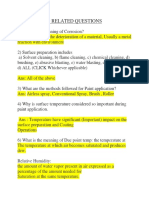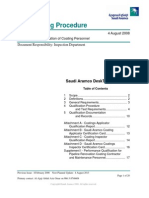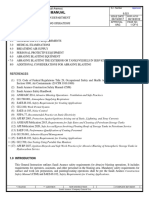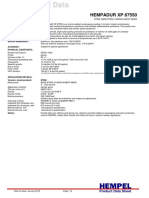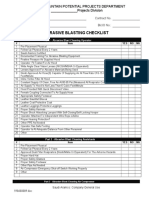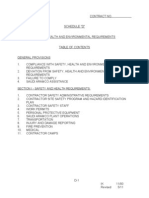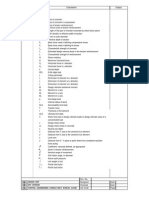Saudi Arabian Oil Company (Saudi Aramco) : General Instruction Manual
Saudi Arabian Oil Company (Saudi Aramco) : General Instruction Manual
Uploaded by
Elie AouadCopyright:
Available Formats
Saudi Arabian Oil Company (Saudi Aramco) : General Instruction Manual
Saudi Arabian Oil Company (Saudi Aramco) : General Instruction Manual
Uploaded by
Elie AouadOriginal Title
Copyright
Available Formats
Share this document
Did you find this document useful?
Is this content inappropriate?
Copyright:
Available Formats
Saudi Arabian Oil Company (Saudi Aramco) : General Instruction Manual
Saudi Arabian Oil Company (Saudi Aramco) : General Instruction Manual
Uploaded by
Elie AouadCopyright:
Available Formats
Saudi Aramco 7180 (5/89)
SAUDI ARABIAN OIL COMPANY (Saudi Aramco) G. I. NUMBER Approved
GENERAL INSTRUCTION MANUAL 6.021
ISSUE DATE REPLACES
ISSUING ORG. LOSS PREVENTION DEPARTMENT
6/19/2012 4/25/2007
APPROVAL PAGE NO.
SUBJECT ABRASIVE BLASTING OPERATIONS
HJK 1 OF 5
CONTENTS
1. INTRODUCTION
2. GENERAL SAFETY REQUIREMENTS
3. MEDICAL EXAMINATIONS
4. BREATHING AIR SUPPLY
5. PERSONAL PROTECTIVE EQUIPMENT
6. ABRASIVE BLASTING EQUIPMENT
7. ABRASIVE BLASTING THE EXTERIOR OF STORAGE TANKS
8. ADDITIONAL CONSIDERATIONS FOR ABRASIVE BLASTING
REFERENCES—Latest Edition
(1) U.S. Code of Federal Regulations Title 29, Occupational Safety and Health Administration, Labor, Part
1910, Section 1000, Air Contaminants (29 CFR 1910.1000)
(2) Saudi Aramco Construction Safety Manual
**(3) Saudi Aramco Safety Handbook
(4) ANSI/ASC Z9.4, Abrasive Blasting Operations - Ventilation and Safe Practices
(5) GI 1780.001 - Atmosphere-Supplying Respirators
(6) SAES-H-102 - Safety Requirements for Coating Applications
(7) GI 2.100 - Work Permit System
(8) SAES-A-105 - Noise Control
(9) NFPA 77, Recommended Practice on Static Electricity
(10) API RP 2003, Protection Against Ignitions Arising out of Static, Lightning, and Stray Currents
(11) ANSI/API Publication 2015, Requirements for Safe Entry and Cleaning of Petroleum Storage Tanks
(12) API Publication 2026, Safe Access/Egress Involving Floating Roofs of Storage Tanks in Petroleum Service
**(13) SAEP-316, Performance Qualification of Coating Personnel
(14) GI 150.001 - Asbestos Hazard Management
1. INTRODUCTION
This General Instruction outlines Saudi Aramco safety requirements for abrasive blasting operations. It
includes requirements for operators, assistants, and other personnel in the area. Mandatory safety
requirements for surface and work site preparation, and painting/coating operations shall be per the Saudi
Aramco Construction Safety Manual and SAES-H-102, Safety Requirements for Coating Applications.
* CHANGE ** ADDITION NEW INSTRUCTION COMPLETE REVISION
Saudi Aramco 7180 (5/89)
SAUDI ARABIAN OIL COMPANY (Saudi Aramco) G. I. NUMBER Approved
GENERAL INSTRUCTION MANUAL 6.021
ISSUE DATE REPLACES
ISSUING ORG. LOSS PREVENTION DEPARTMENT
6/19/2012 4/25/2007
APPROVAL PAGE NO.
SUBJECT ABRASIVE BLASTING OPERATIONS
HJK 2 OF 5
2. GENERAL SAFETY REQUIREMENTS
2.1 Abrasive blasting operations require a HOT WORK permit as it could generate static electricity that
can ignite flammables. Therefore, combustible gas testing shall be carried out prior to commencing
abrasive blasting operations. Other hot work requirements shall be adhered to as stipulated in GI
2.100.
2.2 Where abrasive blasting is to be carried out in a confined space, confined space entry procedures
must be followed (see GI 2.100, Work Permit System, and the Saudi Aramco Construction Safety
Manual).
2.3 SAES-A-105, Noise Control, shall be referred to for details about allowable noise levels and
exposure durations for workers. When noise levels exceed 85 dBA, hearing protection shall be
worn by all personnel in the work area.
2.4 All abrasive blasting operators shall be trained in the correct use and hazards associated with
abrasive blasting equipment and abrasive materials.
**2.5 Abrasive blasting operators for industrial coatings applications shall be tested and certified by a
Certified Coatings Inspector in accordance with SAEP-316.
2.6 Surfaces other than those being blasted shall be protected from damage due to abrasive blasting
operations.
2.7 An abrasive blasting gun must never be pointed at any person or part of the body as a serious injury
could result.
2.8 Areas where abrasive blasting is in progress shall be barricaded to keep unauthorized personnel out
of the hazardous area. Warning signs shall be posted at the hazardous areas with suitable warnings
of the potential dangers (e.g., "No Entry-Abrasive Blasting in Progress").
2.9 Before abrasive blasting any in-service equipment (piping, tanks, vessels, etc.), ensure that non-
destructive testing has been carried out or other methods used to determine that the equipment wall
thickness is adequate for abrasive blasting.
*3. MEDICAL EXAMINATIONS
Saudi Aramco supervisors shall contact the Occupational Medicine Section, Preventive Medicine Services
Division, to arrange for a pre-placement medical examination for their employees assigned to abrasive
blasting operations, including a chest X-ray and a pulmonary function study. These examinations shall be
repeated at least every two years. Contractors shall establish equivalent bio-monitoring programs (using
non-Saudi Aramco medical facilities) for their employees who conduct abrasive blasting for Saudi Aramco.
* CHANGE ** ADDITION NEW INSTRUCTION COMPLETE REVISION
Saudi Aramco 7180 (5/89)
SAUDI ARABIAN OIL COMPANY (Saudi Aramco) G. I. NUMBER Approved
GENERAL INSTRUCTION MANUAL 6.021
ISSUE DATE REPLACES
ISSUING ORG. LOSS PREVENTION DEPARTMENT
6/19/2012 4/25/2007
APPROVAL PAGE NO.
SUBJECT ABRASIVE BLASTING OPERATIONS
HJK 3 OF 5
The results of the medical examinations shall be available if requested by the Saudi Aramco Medical
Services Organization.
4. BREATHING AIR SUPPLY
4.1 Breathing air shall meet the requirements and be tested in accordance with GI 1780.001,
Atmosphere-Supplying Respirators.
** 4.2 Abrasive blasting breathing air equipment shall include a high-efficiency breathing air filter and
water/oil traps before the filter in the breathing air delivery system to remove moisture, oil mist and
particulates. Continuous inline carbon monoxide (CO) monitoring with an audible alarm shall be
provided for oil lubricated breathing air compressors.
** 4.3 Breathing air filters shall be periodically checked and replaced as recommended by the compressor
manufacturer, but not less than every three months. Air filters shall be replaced sooner if there are
objectionable odors or if the filter passes moisture. Water/oil traps shall be checked and drained
daily.
** 4.4 Air compressors supplying breathing air shall be inspected, tested, maintained and used in
accordance with the Saudi Aramco Construction Safety Manual.
4.5 The concentration of air contaminants being inhaled by operators or other personnel within the area
shall not exceed Permissible Exposure Limits (PELs). Since PELs are normally exceeded at
abrasive blasting operations, the Personal Protective Equipment (PPE) for respiratory protection
described in Section 5 shall be worn.
5. PERSONAL PROTECTIVE EQUIPMENT
5.1 Abrasive blasting operators shall wear an air supplied hood, type "CE" supplied-air respirator,
approved for abrasive blasting by the U.S. National Institute for Occupational Safety and Health
(NIOSH) or an equivalent organization as determined by the Loss Prevention Department. Other
workers in or around the work area must wear a high efficiency dust-filter respirator approved by
NIOSH or an approved-equivalent organization for the airborne contaminants likely to occur from
abrasive blasting.
5.2 Abrasive blasting operators shall also wear PPE including safety glasses, heavy duty abrasion
resistant gloves and apron, hearing protection, safety shoes and coveralls. Abrasive blasting
assistants may need all of the above PPE, dependent on their proximity to the abrasive blasting.
Special PPE may be required depending on the work being carried out and the location. Refer to
the Construction Safety Manual or Area Loss Prevention Division.
* CHANGE ** ADDITION NEW INSTRUCTION COMPLETE REVISION
Saudi Aramco 7180 (5/89)
SAUDI ARABIAN OIL COMPANY (Saudi Aramco) G. I. NUMBER Approved
GENERAL INSTRUCTION MANUAL 6.021
ISSUE DATE REPLACES
ISSUING ORG. LOSS PREVENTION DEPARTMENT
6/19/2012 4/25/2007
APPROVAL PAGE NO.
SUBJECT ABRASIVE BLASTING OPERATIONS
HJK 4 OF 5
6. ABRASIVE BLASTING EQUIPMENT
**6.1 An electrical bonding system for nozzle, hose, blasting equipment and the material being blasted
shall be provided, and this bonding system shall be grounded to prevent a buildup of static
electricity. Grounding wire shall be 21 mm2 (AWG-4) or larger. Ground continuity tests shall be
conducted by an electrician to ensure proper grounding (resistance one megaohm or less). Bonding
and grounding connections shall be inspected before each job is started and whenever equipment is
repositioned.
6.2 Hoses and nozzle fittings shall be securely attached (safety wired) to prevent unplanned
disengagement during abrasive blasting operations.
6.3 Abrasive blasting equipment shall be designed to automatically shut off (deadman’s switch) the
flow of abrasive and propellant if for any reason the operator releases the control switch.
6.4 Abrasive blast cleaning equipment may only be operated with all protective guards and controls in
place and working properly.
7. ABRASIVE BLASTING THE EXTERIOR OF STORAGE TANKS
7.1 Tanks shall be considered in-service when they are pressurized or contain hydrocarbons, other
flammable or combustible products, or if any inlet, outlet or overhead piping connected to the tank
is not blinded.
7.2 Abrasive blasting the exterior of in-service floating roof tanks is not allowed above the wind girder.
No abrasive blasting shall take place on the roof or interior tank wall of an in-service floating roof
tank.
7.3 Cone roof atmospheric storage tanks can be externally abrasive blasted while in service provided
that the roof is structurally safe for personnel movement, periodic gas test results indicate that there
are no flammables present, connections and instrumentation are protected against damage, and all
general safety requirements have been met.
7.4 The Work Permit System shall be used and gas tests shall be carried out in the area to be abrasive
blasted, in addition to areas where abrasive blasting hoses, equipment and compressors are located.
7.5 Minimize the amount of abrasive blasting equipment inside dikes. The abrasive blasting machine
shall be located at grade level and upwind from the tank.
7.6 The abrasive blasting machine and hose couplings shall be grounded at grade level or bonded to the
storage tank. The abrasive blasting nozzle shall be bonded to the work surface or both the nozzle
and the work surface shall be effectively grounded.
* CHANGE ** ADDITION NEW INSTRUCTION COMPLETE REVISION
Saudi Aramco 7180 (5/89)
SAUDI ARABIAN OIL COMPANY (Saudi Aramco) G. I. NUMBER Approved
GENERAL INSTRUCTION MANUAL 6.021
ISSUE DATE REPLACES
ISSUING ORG. LOSS PREVENTION DEPARTMENT
6/19/2012 4/25/2007
APPROVAL PAGE NO.
SUBJECT ABRASIVE BLASTING OPERATIONS
HJK 5 OF 5
7.7 To prevent overloading, the abrasive material shall not be allowed to accumulate on items that
could be damaged, such as the roof or scaffolding.
*7.8 For cone roof tanks additional precautions shall be taken:
7.8.1 Vents in the area of abrasive blasting shall be sealed; at least one vent depending on tank
capacity and product handled shall be fitted with a 2.5 meter (8 ft.) vent stack.
7.8.2 Product transfer shall not be performed while abrasive blasting is in progress. NOTE:
Ensure that the seals on vents are removed before the tank is pumped out or receives
product.
7.8.3 Work shall be carried out upwind of the functional tank vent(s).
7.9 The abrasive blasting of refrigerated LPG dome roof atmospheric storage tanks shall be treated on a
case-by-case basis and the abrasive blasting procedure shall be reviewed by the Chief Fire
Prevention Engineer, Loss Prevention Department.
8. ADDITIONAL CONSIDERATIONS FOR ABRASIVE BLASTING
8.1 Silica sand and combustible abrasives are prohibited at all Saudi Aramco facilities and construction
sites.
8.2 The type of coating to be removed by abrasive blasting shall be evaluated for hazards from residue.
Where uncertainty exists, tests shall be carried out to determine the potential health or
environmental hazards as well as required additional protective measures.
8.3 Abrasive blasting residue shall be cleaned up regularly and disposed of in accordance with the
recommendations of the Environmental Protection Department.
8.4 If the work entails removal or disturbance of asbestos containing materials, all requirements in GI
150.001, Asbestos Hazard Management, shall be complied with.
APPROVED: _______________________ DATE: _________________
MANAGER
Loss Prevention Department
* CHANGE ** ADDITION NEW INSTRUCTION COMPLETE REVISION
You might also like
- COATING Aramco QuestionsDocument24 pagesCOATING Aramco QuestionsDavid Salguero100% (15)
- SMG 07-005 Application of Saudi Aramco Building Code To Contractors 2021-11-25Document38 pagesSMG 07-005 Application of Saudi Aramco Building Code To Contractors 2021-11-25baseet gazaliNo ratings yet
- 0002 - 100 Work Permit SystemDocument6 pages0002 - 100 Work Permit SystemOmar Santos86% (22)
- Saep 316Document20 pagesSaep 316brecht1980100% (18)
- General Instruction Manual: Saudi Arabian Oil Company (Saudi Aramco)Document25 pagesGeneral Instruction Manual: Saudi Arabian Oil Company (Saudi Aramco)parijat pramanik100% (1)
- G.I. 6.003 - Incident Investigation PDFDocument11 pagesG.I. 6.003 - Incident Investigation PDFJoypee Macasampon50% (4)
- GI 2.709 Gas Testing PDFDocument12 pagesGI 2.709 Gas Testing PDFMANI DEEP75% (4)
- Schedule D HSE RequirementDocument17 pagesSchedule D HSE RequirementEngr.Syed AmjadNo ratings yet
- FRCGuideDocument7 pagesFRCGuideHaleem Ur Rashid Bangash0% (1)
- General Instruction Manual: Saudi Arabian Oil Company (Saudi Aramco)Document25 pagesGeneral Instruction Manual: Saudi Arabian Oil Company (Saudi Aramco)Nasir IrfaniNo ratings yet
- Content:: Saudi Arabian Oil Company (Saudi Aramco) General Instruction ManualDocument16 pagesContent:: Saudi Arabian Oil Company (Saudi Aramco) General Instruction Manualbryan100% (1)
- Gi-7.025 Heavy Equipment Operator Testing and CertificationDocument1 pageGi-7.025 Heavy Equipment Operator Testing and CertificationAkbarShareef60% (5)
- CSM - Contractor Site Administrative Requirements (CSAR) November 2019 RevisionsDocument6 pagesCSM - Contractor Site Administrative Requirements (CSAR) November 2019 RevisionsAkash K Nair100% (2)
- Gi 6.008 Restriction of Portable Electrical - ElectronicDocument5 pagesGi 6.008 Restriction of Portable Electrical - ElectronicAhmed ShoreemNo ratings yet
- G.I. 150.002 First Aid-CPR Training and First Aid KitsDocument5 pagesG.I. 150.002 First Aid-CPR Training and First Aid KitsAbdulwahid KhakiNo ratings yet
- Sika Saudi Arabia: Safety Data SheetDocument4 pagesSika Saudi Arabia: Safety Data Sheetusman khalid50% (2)
- 0006 007Document10 pages0006 007Genaro Paypa100% (4)
- Content:: Saudi Arabian Oil Company (Saudi Aramco) General Instruction ManualDocument4 pagesContent:: Saudi Arabian Oil Company (Saudi Aramco) General Instruction Manualjhoni100% (1)
- Coating Crew SupervisorDocument4 pagesCoating Crew Supervisorimtiaz100% (2)
- 1C.cv - Talha Abdullah (Painting Crew Supervisor)Document2 pages1C.cv - Talha Abdullah (Painting Crew Supervisor)Mohamed Reda100% (2)
- Aramco GenDocument21 pagesAramco GenHaleem Ur Rashid Bangash0% (1)
- 0006 - 007-Reporting of Contractor On-Job Injuries Occupational Illnesses PDFDocument10 pages0006 - 007-Reporting of Contractor On-Job Injuries Occupational Illnesses PDFIssac JohnNo ratings yet
- Apcs 113a-87550Document2 pagesApcs 113a-87550jojo_32343% (7)
- Job Safety Analysis Work SheetDocument7 pagesJob Safety Analysis Work SheetTomNo ratings yet
- GI 2.718, Contractor Site Allotment ProcedureDocument12 pagesGI 2.718, Contractor Site Allotment ProcedureSajid Hussain100% (1)
- Aramco Standards-B-4 & 5 For H2S-2013Document35 pagesAramco Standards-B-4 & 5 For H2S-2013Nehemiah Cervantes100% (3)
- Manual Relogio Comparador Manuel SYL S229 EDocument14 pagesManual Relogio Comparador Manuel SYL S229 EBRUNA MULLERNo ratings yet
- API 618 Compressors1 PDFDocument0 pagesAPI 618 Compressors1 PDFAnonymous ffje1rpaNo ratings yet
- Quiz-Bee-7-10 EnglishDocument6 pagesQuiz-Bee-7-10 EnglishDios Mureen Riñon100% (7)
- General Instruction Manual: Abrasive Blasting OperationsDocument6 pagesGeneral Instruction Manual: Abrasive Blasting OperationsAbhilashNo ratings yet
- Gi-0008 001Document8 pagesGi-0008 001Tasasdaq khan100% (1)
- Saudi Arabian Oil Company (Saudi Aramco) General Instruction ManualDocument12 pagesSaudi Arabian Oil Company (Saudi Aramco) General Instruction ManualJoypee MacasamponNo ratings yet
- General Instruction Manual: Gas Testing Using Portable Gas MonitorsDocument11 pagesGeneral Instruction Manual: Gas Testing Using Portable Gas Monitorskhrayzie bhoneNo ratings yet
- 0008 - 001 Safety Requirements For ScaffoldsDocument16 pages0008 - 001 Safety Requirements For Scaffoldsshahid zaheer100% (1)
- Gi-2 401Document7 pagesGi-2 401ck19654840No ratings yet
- General Instruction Gi 7 029Document8 pagesGeneral Instruction Gi 7 029mohamedNo ratings yet
- Gi-0006 005Document8 pagesGi-0006 005khrayzie bhoneNo ratings yet
- Gi-2 104Document10 pagesGi-2 104ck19654840No ratings yet
- Schedule DDocument19 pagesSchedule DwangruiNo ratings yet
- G.I. 151.006 Implementing Sanitary CodeDocument5 pagesG.I. 151.006 Implementing Sanitary Codebryan100% (5)
- Hempadur XP 87550: DescriptionDocument2 pagesHempadur XP 87550: DescriptionEngTamer50% (4)
- Apcs 113a Rev 3 Pid ApprovalDocument19 pagesApcs 113a Rev 3 Pid ApprovalMedel Cay De Castro50% (2)
- General Instruction Gi 7 025Document9 pagesGeneral Instruction Gi 7 025mohamedNo ratings yet
- L6.01 Abrasive Blasting Check ListDocument3 pagesL6.01 Abrasive Blasting Check ListNATIONAL BASICS COMPANY100% (1)
- Saep 316 2016 PDFDocument25 pagesSaep 316 2016 PDFAllan LindoNo ratings yet
- Part I - 04 Work Permit SystemDocument7 pagesPart I - 04 Work Permit Systemsalah abddayem100% (1)
- Schedule DDocument17 pagesSchedule DSIVA100% (4)
- Part II - 08 Abrasive BlastingDocument5 pagesPart II - 08 Abrasive Blastingsalah abddayemNo ratings yet
- CSM by AramcoDocument3 pagesCSM by AramcoSharifullahNo ratings yet
- WPR Q&a PDFDocument5 pagesWPR Q&a PDFAhtesham AlamNo ratings yet
- General Instruction Manual: ContentDocument13 pagesGeneral Instruction Manual: Contentck19654840No ratings yet
- Schedule B - Attachment IDocument27 pagesSchedule B - Attachment Imunna100% (2)
- Aramco Painting SpecificationDocument6 pagesAramco Painting Specificationvicky100% (1)
- 0006 005 Reporting Investigation and Recording of Injuries Occupational Illnesses PDFDocument11 pages0006 005 Reporting Investigation and Recording of Injuries Occupational Illnesses PDFdan0427No ratings yet
- G.I. 6.004 - Near Miss Reporting Process PDFDocument5 pagesG.I. 6.004 - Near Miss Reporting Process PDFJoypee MacasamponNo ratings yet
- General Instruction Manual: Saudi Arabian Oil Company (Saudi Aramco)Document25 pagesGeneral Instruction Manual: Saudi Arabian Oil Company (Saudi Aramco)parijat pramanikNo ratings yet
- Asbestos Hazard ManagementDocument8 pagesAsbestos Hazard Managementsajidazmi.amuNo ratings yet
- Content:: 150.001 Saudi Arabian Oil Company (Saudi Aramco) General Instruction ManualDocument8 pagesContent:: 150.001 Saudi Arabian Oil Company (Saudi Aramco) General Instruction ManualAnonymous voA5Tb0No ratings yet
- 0006 - 020-Personal Flotation Devices For Work Over, On or NeaDocument7 pages0006 - 020-Personal Flotation Devices For Work Over, On or NeaSAQIBNo ratings yet
- General Instruction Manual: Saudi Arabian Oil Company (Saudi Aramco)Document14 pagesGeneral Instruction Manual: Saudi Arabian Oil Company (Saudi Aramco)Aldrien CabinteNo ratings yet
- Work Permit System PDFDocument7 pagesWork Permit System PDFSayed DarwishNo ratings yet
- Saudi Arabian Oil Company (Saudi Aramco) General Instruction ManualDocument19 pagesSaudi Arabian Oil Company (Saudi Aramco) General Instruction ManualEagle Spirit100% (1)
- 0007 - 029 Rigging Hardware RequirementsDocument7 pages0007 - 029 Rigging Hardware Requirementsaswinsarensnass25No ratings yet
- Cent Vs Decent AC Systems 22Document1 pageCent Vs Decent AC Systems 22Elie AouadNo ratings yet
- Cent Vs Decent AC Systems 9Document1 pageCent Vs Decent AC Systems 9Elie AouadNo ratings yet
- Cent Vs Decent AC Systems 2Document1 pageCent Vs Decent AC Systems 2Elie AouadNo ratings yet
- Pittseal CW Sealant: 1. Description and Area of ApplicationDocument3 pagesPittseal CW Sealant: 1. Description and Area of ApplicationElie AouadNo ratings yet
- AEFAC-TN06-concrete 4Document1 pageAEFAC-TN06-concrete 4Elie AouadNo ratings yet
- AEFAC-TN06-concrete 3Document1 pageAEFAC-TN06-concrete 3Elie AouadNo ratings yet
- AEFAC-TN06-concrete 2Document1 pageAEFAC-TN06-concrete 2Elie AouadNo ratings yet
- bs-7570 Part5Document2 pagesbs-7570 Part5Elie AouadNo ratings yet
- The Difference Between Reason and Will Reason and WillDocument20 pagesThe Difference Between Reason and Will Reason and WillRotsen YodicoNo ratings yet
- Ao Cap Carles 3.0Document54 pagesAo Cap Carles 3.0Jeremiah T. PudaderaNo ratings yet
- A Report On: Hook'S Law and A Simple SpringDocument12 pagesA Report On: Hook'S Law and A Simple SpringAnonymous KyrWzrm5vNo ratings yet
- Bone Marrow Biopsy SheetDocument2 pagesBone Marrow Biopsy SheetSouvik BairagyaNo ratings yet
- Lampiran Spesifikasi Teknis Pengadaan Bahan CRM (Certified Reference Material)Document10 pagesLampiran Spesifikasi Teknis Pengadaan Bahan CRM (Certified Reference Material)Hendar Tubagus IMNo ratings yet
- Neural NetworkDocument54 pagesNeural NetworkPratik Agrawal100% (1)
- Decena, Lance Adrian S. Me2a Ethics Act #2Document4 pagesDecena, Lance Adrian S. Me2a Ethics Act #2Jarius CabrizaNo ratings yet
- AppNote AAS novAA 800 0007 en Milk PowderDocument7 pagesAppNote AAS novAA 800 0007 en Milk PowderAndrewNo ratings yet
- sg3525 ONDocument10 pagessg3525 ONbob75No ratings yet
- For Song of Drums and Shakos: Ottoman TurksDocument5 pagesFor Song of Drums and Shakos: Ottoman TurksthindolNo ratings yet
- Swa Classifieds 050814Document3 pagesSwa Classifieds 050814Digital MediaNo ratings yet
- Interpretation of Test ResultsDocument27 pagesInterpretation of Test ResultsJovee Mae MayorNo ratings yet
- Three-Phase Induction Motor Dynamic Mathematical ModelDocument3 pagesThree-Phase Induction Motor Dynamic Mathematical Modelsajs201100% (3)
- rv4-65d-r5-v3-product-specificationsDocument4 pagesrv4-65d-r5-v3-product-specificationsuniversaldoneNo ratings yet
- The Erotic Imagination French Histories of PerversityDocument264 pagesThe Erotic Imagination French Histories of PerversityJohn DaemonsNo ratings yet
- Port Master Plan 2040 For WebDocument43 pagesPort Master Plan 2040 For WebVagner Jose100% (1)
- Chapter 4 - Quantitative Warehouse Planning Models (Full)Document59 pagesChapter 4 - Quantitative Warehouse Planning Models (Full)Nguyễn Duy ThuậnNo ratings yet
- Purpose: Partition CoefficientDocument5 pagesPurpose: Partition CoefficientJamesNo ratings yet
- Control Valve SizingDocument3 pagesControl Valve SizingN. S. PanditNo ratings yet
- Nvidia Quadro Sales GuideDocument16 pagesNvidia Quadro Sales GuidePhan Xuân TuấnNo ratings yet
- The Mandalorian S02E03 WEBRip x264-ION10Document28 pagesThe Mandalorian S02E03 WEBRip x264-ION10AlexJKDCQCNo ratings yet
- Chemistry PracticalDocument13 pagesChemistry PracticalChrome UserNo ratings yet
- Micro Lecture Plan m102 GDocument8 pagesMicro Lecture Plan m102 Gweyekim600No ratings yet
- Changing The Gain in 2B Power Amplifiers: R4 R1 C3 (R5) C4 C5Document1 pageChanging The Gain in 2B Power Amplifiers: R4 R1 C3 (R5) C4 C5ciohaniNo ratings yet
- Catalogo PMI PDFDocument276 pagesCatalogo PMI PDFArt ManNo ratings yet
- Box Culvert DesignDocument14 pagesBox Culvert Designjohney2No ratings yet
- Esoteric AcupunctureDocument3 pagesEsoteric AcupunctureOrlando Rodriguez UrriolaNo ratings yet
